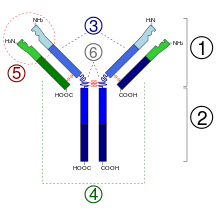
1. Antigen-binding fragment (Fab)
2. Antibody crystallizable region (Fc)
3. Heavy chains
4. Light chains
5. Variable region of the antibody. The paratope is the key-shaped section that makes direct contact with the antigen.[1]
6. Hinge regions
In immunology, a paratope, also known as an antigen-binding site, is the part of an antibody which recognizes and binds to an antigen.[1][2] It is a small region at the tip of the antibody's antigen-binding fragment and contains parts of the antibody's heavy and light chains.[1][2] Each paratope is made up of six complementarity-determining regions - three from each of the light and heavy chains - that extend from a fold of anti-parallel beta sheets.[2] Each arm of the Y-shaped antibody has an identical paratope at the end.[2]
Paratopes make up the parts of the B-cell receptor that bind to and make contact with the epitope of an antigen.[2] All the B-cell receptors on any one individual B cell have identical paratopes.[2] The uniqueness of a paratope allows it to bind to only one epitope with high affinity and as a result, each B cell can only respond to one epitope. The paratopes on B-cell receptors binding to their specific epitope is a critical step in the adaptive immune response.
- ^ a b c Lefranc MP (2013). "Paratope". In Dubitzky W, Wolkenhauer O, Cho KH, Yokota H (eds.). Encyclopedia of Systems Biology. New York, NY: Springer. pp. 1632–1633. doi:10.1007/978-1-4419-9863-7_673. ISBN 978-1-4419-9863-7.
- ^ a b c d e f Punt J, Stranford SA, Jones PP, Owen JA (2019). Kuby immunology (Eighth ed.). New York. ISBN 978-1-4641-8978-4. OCLC 1002672752.
{{cite book}}: CS1 maint: location missing publisher (link)